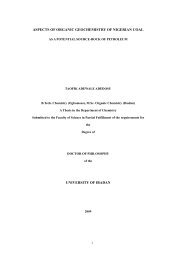- Page 1 and 2: ASPECTS OF ORGANIC GEOCHEMISTRY OF
- Page 3 and 4: ACKNOWLEDGEMENTS All praises are du
- Page 5 and 6: CERTIFICATION This is to certify th
- Page 7 and 8: The distribution patterns of C32-C3
- Page 9 and 10: 1.6.3.2 Biomarker Analysis………
- Page 11 and 12: 4.1.1.2 Mamu Formation…………
- Page 13 and 14: Fig.4.3: Plots of S2 vs. TOC of Coa
- Page 15 and 16: Fig.4.36: m/z 156, 170 Mass chromat
- Page 17 and 18: 1.1 Introduction CHAPTER ONE INTROD
- Page 19 and 20: 1.2.2 Coalification This is the pro
- Page 21 and 22: The longer the aliphatic chains the
- Page 23 and 24: Fig. 1.1 : Location of Anambra Basi
- Page 25 and 26: 1.6 Petroleum Source Rock Evaluatio
- Page 27 and 28: The type II kerogen has relatively
- Page 29 and 30: Organic petrographers also develope
- Page 31 and 32: 2.1 Biomarker Geochemistry CHAPTER
- Page 33 and 34: However, the ratio is known to be a
- Page 35 and 36: Generally, short chain n-fatty acid
- Page 37 and 38: Their derivatives were reported onl
- Page 39 and 40: Fig. 2.1 (contd.): Chemical structu
- Page 41 and 42: Sponges are the only marine organis
- Page 43 and 44: The use of α-and β- amyrins as te
- Page 45: High abundance of C35 hopane usuall
- Page 49 and 50: A variety of aromatic maturity para
- Page 51 and 52: more stable β-substituted isomer (
- Page 53 and 54: Also, it has been shown that n-alka
- Page 55 and 56: The distribution pattern of individ
- Page 57 and 58: 2.3.3 Sulphur Isotopes Sulphur isot
- Page 59 and 60: 2.4.1.1 Flash or Rapid temperature-
- Page 61 and 62: S2 S1 Free hydrocarbon, FID Hydroca
- Page 63 and 64: 2.4.2 Gas chromatography/Mass spect
- Page 65 and 66: Based on the comparison of δD valu
- Page 67 and 68: Fig. 2.4 :Geological map of Benue T
- Page 69 and 70: The shale limestone sequence formed
- Page 71 and 72: CHAPTER THREE EXPERIMENTAL 3.1 SAMP
- Page 73 and 74: Fig. 3.2: Lithographic section of O
- Page 75 and 76: 3.1.5 Derivatisation of Polar fract
- Page 77 and 78: 3.2.5. Gas chromatography-isotope r
- Page 79 and 80: 4.1.1.2 Mamu Formation The C conten
- Page 81 and 82: Fig. 4.1: Plot of Atomic H/C agains
- Page 83 and 84: Samples Awgu Formation LB387 Lithol
- Page 85 and 86: Fig. 4.2 : Plots of HI vs OI of Coa
- Page 87 and 88: Fig. 4.3 : Plots of S2 vs TOC of Co
- Page 89 and 90:
Vitrinite reflectance values were e
- Page 91 and 92:
Fig. 4.6 : Plots of HI vs Tmax of C
- Page 93 and 94:
4.3 Biomarker Geochemistry of the N
- Page 95 and 96:
Fig. 4.8 (contd.): m/z 85 Mass chro
- Page 97 and 98:
Fig. 4.9 (contd.): m/z 85 Mass chro
- Page 99 and 100:
Fig. 4.10 (contd.): m/z 85 Mass chr
- Page 101 and 102:
Fig. 4.11: Plots of Pr/nC17 against
- Page 103 and 104:
4.3.1.2 Mamu Formation The n-alkane
- Page 105 and 106:
Fig. 4.13: m/z 74 mass chromatogram
- Page 107 and 108:
Fig. 4.14: m/z 74 mass chromatogram
- Page 109 and 110:
Fig. 4.15 (contd.): m/z 74 mass chr
- Page 111 and 112:
Fig. 4.17: m/z 58 mass chromatogram
- Page 113 and 114:
Table 4.4: Parameters calculated fr
- Page 115 and 116:
Various ratios of tricyclic terpane
- Page 117 and 118:
Fig. 4.20: m/z 191 showing the dist
- Page 119 and 120:
Sample Table 4.5 : Tri- and tetracy
- Page 121 and 122:
The ratio values (
- Page 123 and 124:
Fig. 4.23 : m/z 191 Mass chromatogr
- Page 125 and 126:
Table 4.6 : Peak identities on m/z
- Page 127 and 128:
Samples Awgu Formation Depth (m) Ta
- Page 129 and 130:
4.3.4.2 Mamu Formation The C27 to C
- Page 131 and 132:
Fig. 4.26: Mass frangmentogram and
- Page 133 and 134:
Three isomers of oleanenes; olean-1
- Page 135 and 136:
Fig. 4.28 : m/z 217 mass chromatogr
- Page 137 and 138:
Fig. 4.30 : m/z 217 mass chromatogr
- Page 139 and 140:
Fig. 4.31 : Ternary plots of C27, C
- Page 141 and 142:
Fig. 4.33 : Plots of 22S/22S+22R C3
- Page 143 and 144:
The 20S/20S+20R and αββ/αββ+
- Page 145 and 146:
Fig. 4.34 : m/z 156, 170 mass chrom
- Page 147 and 148:
Fig. 4.35 : m/z 156, 170 mass chrom
- Page 149 and 150:
Table 4.10 : Peak identities on m/z
- Page 151 and 152:
Various maturity parameters calcula
- Page 153 and 154:
Fig. 4.38 : m/z 178, 192, 206 mass
- Page 155 and 156:
Table 4.11 : Peak identities on m/z
- Page 157 and 158:
Fig. 4.40 :Organic matter source di
- Page 159 and 160:
4.4.3.1 Awgu Formation Dibenzothiop
- Page 161 and 162:
Fig. 4.41 (contd.): m/z 184,198,212
- Page 163 and 164:
Fig. 4.42 : Cross plot of total Sul
- Page 165 and 166:
Fig. 4.44 : Cross plot of dibenzoth
- Page 167 and 168:
4.4.3.2 Mamu Formation The dibenzot
- Page 169 and 170:
Table 4.14: Carbon Isotopic Composi
- Page 171 and 172:
4.5.1.2 Mamu Formation The δ 13 C
- Page 173 and 174:
Fig. 4.47: Carbon isotopic distribu
- Page 175 and 176:
CHAPTER FIVE SUMMARY AND CONCLUSION
- Page 177 and 178:
REFERENCES Abubakar, M.B., Obaje, N
- Page 179 and 180:
Barthlot, W., Neinhuis, C., Cutler,
- Page 181 and 182:
oil and gas, a case study from the
- Page 183 and 184:
Chemical Geology 20:205-221. Cranwe
- Page 185 and 186:
Ellis, V.O., De Baroos, A.M.A., De
- Page 187 and 188:
Geochimica et Cosmochimica 43:739-7
- Page 189 and 190:
Kleemann, G., Poralla, K., Englert,
- Page 191 and 192:
Mackenzie, A.S. 1984. Application o
- Page 193 and 194:
Norgate, C. M., Boreham, C. J. and
- Page 195 and 196:
Peters, S.W. 1982.Central West Afri
- Page 197 and 198:
Revill, A.T., Volkman, J.K., O’Le
- Page 199 and 200:
Schwark, L. Vliex, M. and Schaeffer
- Page 201 and 202:
Stefanova, M., Markova, K., Marinov
- Page 203 and 204:
Cosmochimica Acta 56: 1231-1246. Va
- Page 205 and 206:
Wen, Z., Ruiyog, W., Radke, M., Qin
- Page 207 and 208:
Fig. 4.8 : m/z 85 Mass chromatogram
- Page 209 and 210:
Fig. 4.9 : m/z 85 Mass chromatogram
- Page 211 and 212:
Fig. 4.10 : m/z 85 Mass chromatogra
- Page 213 and 214:
Fig. 4.13: m/z 74 mass chromatogram
- Page 215 and 216:
Fig. 4.14: m/z 74 mass chromatogram
- Page 217 and 218:
Fig. 4.15 (contd.): m/z 74 mass chr
- Page 219 and 220:
Fig. 4.17: m/z 58 mass chromatogram
- Page 221 and 222:
Fig. 4.19 :m/z 191 showing the dist
- Page 223 and 224:
Fig. 4.21 : m/z 191 showing the dis
- Page 225 and 226:
Fig. 4.23 : m/z 191 Mass chromatogr
- Page 227 and 228:
Fig. 4.28 : m/z 217 mass chromatogr
- Page 229 and 230:
Fig. 4.30 : m/z 217 mass chromatogr
- Page 231 and 232:
Fig. 4.34 (contd.): m/z 156, 170 ma
- Page 233 and 234:
Fig. 4.36 : m/z 156, 170 mass chrom
- Page 235 and 236:
Fig. 4.38 : m/z 178, 192, 206 mass
- Page 237 and 238:
Fig. 4.41: m/z 184,198,212,226 mass
- Page 239:
239


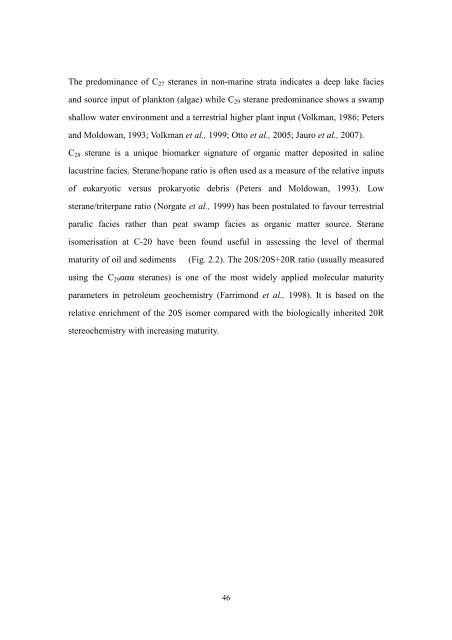

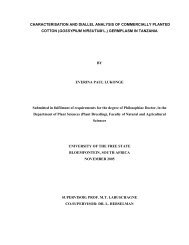


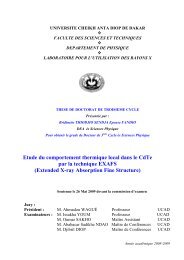
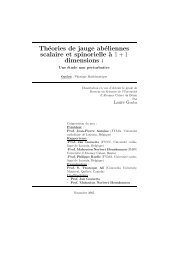
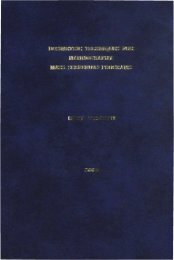

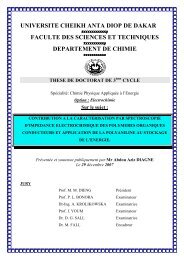
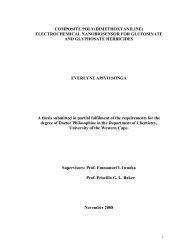


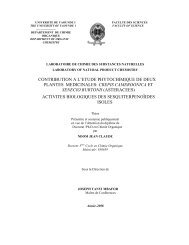
![SYNTHESIS AND ANTI-HIV ACTIVITY OF [d4U]-SPACER-[HI-236 ...](https://img.yumpu.com/30883288/1/190x245/synthesis-and-anti-hiv-activity-of-d4u-spacer-hi-236-.jpg?quality=85)
